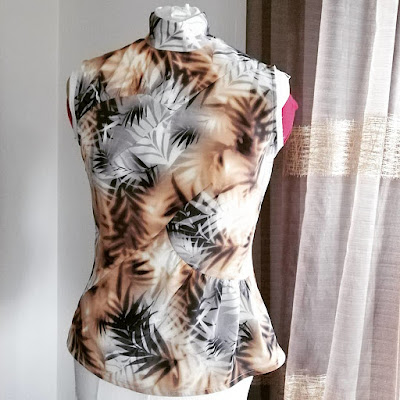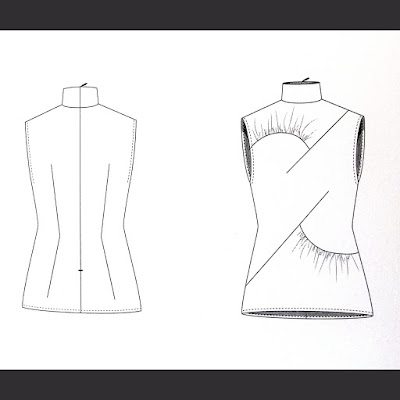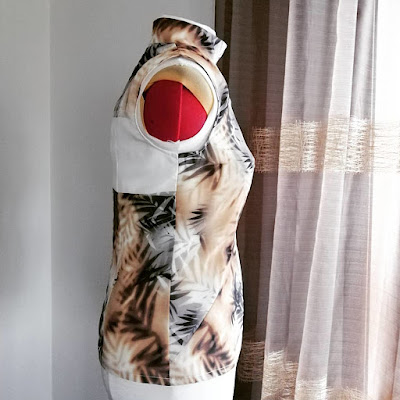EN Summary: "Clin d'oeil" means blink of an eye in English and indeed a blink is all you need to fall in love with this top. Keep reading the full article, which is originally published on tanysewsandknits.blogspot.com blog.
---
PT Sumário: "Clin d'oeil" significa piscar de olho em Português e de facto é quanto baste para nos apaixonar-mos por este top. Continuem a ler o artigo completo, originalmente publicado no blogue tanysewsandknits.blogspot.com.
EN: Le516 is one of the patterns in the book Fashion Couture by DP Studio (read about it here). The pattern is described as top that will enforce your femininity in its purest form. With assumed asymmetry, the combination of round cut panels and gathering will produce the original effect of a wink.
---
PT: Le516 é um dos moldes incluídos no livro Fashion Couture de DP Studio (podem ler sobre o livro aqui). O molde é descrito como um top que irá reforçar a nossa feminilidade na sua forma mais pura. Com assumida assimetria, o seu jogo de recortes arredondados e frazidos cria o original efeito de uma piscadela de olho.
EN: The pattern, offered in a size range 36/S through 48/XL, is close-fitting and sleeveless, with a high turtleneck and center back zipper closure. I cut size 40 and it fits me like a glove. I used a small remnant of fabric (55" wide and little more than a yard long) that I suspect is a rayon/polyester blend (no stretch), which has a nice digital print but included a white border (I'm not sure if the border would repeat along the length of the fabric or if I just caught the end of the roll...). Years ago I must have collected it from the remnants bin at the shop because it has such a nice hand and touch and a really beautiful print... I knew it was barely enough for a top and I originally intended to make a strappy top of some kind. When I realized that le519 would only take 1.10 m of fabric for my size (about 1.2 yards) I looked for small pieces of fabric in my extensive fabric stash and this fabric came up.
In terms of fit, it matters to say that now I am a B-cup and the top fits me wonderfully without any alteration. That being said, if you have to produce an FBA (full bust adjustment) or a SBA (small bust adjustment) on this pattern, it may be difficult. For C cups perhaps using a fabric with some stretch will do the trick.
---
PT: O molde, apresentado numa gama de tamanhos do 36/S ao 48/XL, é um modelo justo e sem mangas, que tem uma gola-alta e um fecho atrás nos meio das costas. Usei um retalho de tecido com pouco mais de um metro por 1.4m de largo que suspeito ser mistura de viscose e poliéster (sem elasticidade), que tem um estampado digital muito bonito. Anos atrás devo te-lo retirado do caixote dos retalhos na loja, porque é apenas um sobrante com uma risca larga em branco (não sei se a risca se repetia ou se foi só o fim do rolo do tecido). Sabia que seria apenas suficiente para um top e pensei fazer um top de alcinhas porque o tecido tinha um toque agradável e um estampado muito bonito. Quando vi que o top Le516 só precisava de 1.10m de tecido, procurei peças de tecido pequenas na minha extensa coleção e este tecido pareceu-me ideal.
Em relação ao ajuste do molde, interessa também referir que agora sou copa B e que o top assenta-me perfeitamente sem qualquer alteração. Se tiverem copas maiores ou mais pequenas, a alteração a fazer pode não ser simples; para uma copa C, é provável que baste usarem um tecido com um pouco de elasticidade.
EN: The print of the fabric may not enhance the panels and gathering on the photos, but they are perceptible in real life:
---
PT: O estampado do tecido pode não evidenciar os detalhes dos cortes e franzidos nas fotos, mas ao vivo eles são bem percetíveis:
EN: There was no way I could avoid the white band in the cutting layout so I turned it into a design feature and cut the back panels so I had it placed on the upper back, just minding that the band would match across both left and right back.
---
PT: Foi impossível evitar a banda branca no plano de corte por isso transformei-a numa opção de design, integrando-a nas costas do top, apenas cuidando para que a banda coincidisse ao longo do centro das costas.
EN: The center back zipper has an inside facing finishing as you can see below:
---
PT: O fecho invisível nas costas tem um acabamento interior com uma vista/guarnição, como podem ver:
EN: I did one small adaptation the the pattern after all: it calls for a 46 cm (18") long invisible zipper and I figured I wouldn't be able to slip such a close fitting top on through the head and shoulders if the zipper opening ended just a tad below the waist level,... So I used a 60 cm (24") invisible zipper instead and lengthened the zipper facing to the hem level. The hem was simply turned in twice and top-stitched, with the facing caught inside:
---
PT: Afinal fiz um pequeno ajuste ao molde: nas instruções diz para usar um fecho invisível de 46cm, mas com este comprimento de fecho a abertura iria terminar cerca da linha da cintura; ora achei que seria difícil enfiar o top pela cabeça e ombros nessas condições, por isso usei um fecho de 60cm. Como é óbvio tive de alongar as vistas/guarnições do fecho, optando por terminá-las na linha da bainha, que foi simplesmente dobrada para dentro duas vezes e pespontada, prendendo as vistas:
EN: Here's the top seen from the side:
---
PT: Aqui têm o top visto de lado:
EN: Here's a close-up on the armhole edge finishing: it is done with 4 cm (1 1/2") wide self-fabric bias strips, folded in half lengthwise (making it 3/4" wide), stitched at 3/8" to the armhole edges from the right side (raw edge with raw edges of the bias band); the raw edges are then trimmed down to 1/4", pressed towards the bias band and under-stitched. At this point the side seams are stitched, ending at an angle at the bias band edge under the armhole (so the bias band can be turned too the wrong side next). Finally the bias band is pressed to the wrong side and top-stitched close to its folded edge. The procedure is thoroughly explained and illustrated in the instructions (note: the instructions are written in French).
---
PT: Aqui têm o detalhe do acabamento das cavas: é confecionado com tiras em viés de 4cm dobradas ao meio no sentido do comprimento (o que faz 2cm), cosidas a 1cm de margem pelo direito às cavas, orla com orla. Depois as margesn são aparadas para 5mm e assentes para o lado do viés. Nesta fase fecham-se as costuras laterais, terminando em ângulo sobre o viés (para podermos virá-lo para dentro a seguir). Finalmente assenta-se o viés para dentro e pesponta-se à cava ao longo da dobra do viés. O processo é explicado e ilustrado em detalhe nas instruções de confeção no livro (notem que as instruções estão em Francês).
CONCLUSION: It's a really lovely top and I highly recommend the pattern. Aside from the zipper issue, I found no problems and/or fails in the pattern. It is true to size according to DP Studio's measurement table and the end result is a top that won't go unnoticed :). Thank you all for reading and for the lovely comments!
---
CONCLUSÃO: É um top verdadeiramente bonito e recomendo vivamente o molde. à parte da questão do zíper, não encontrei qualquer falha ou erro no molde. É fiel à tabela de medidas DP Studio e o resultado final é um top que não passará despercebido :). Obrigada a todos por aparecerem e pelos simpáticos comentários!










Wow! This top, the fabric, your workwomanship it's all mind-blowing beautiful.
ReplyDeletethat is such an interesting pattern. Looks very stylish, and I hope you make it again in a solid.
ReplyDeleteWhat a great style. I'd love to make a top like this.
ReplyDelete